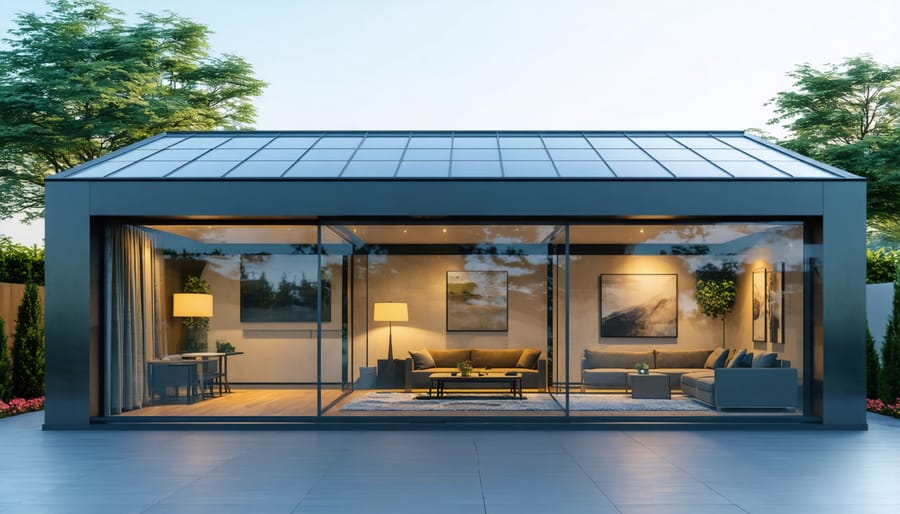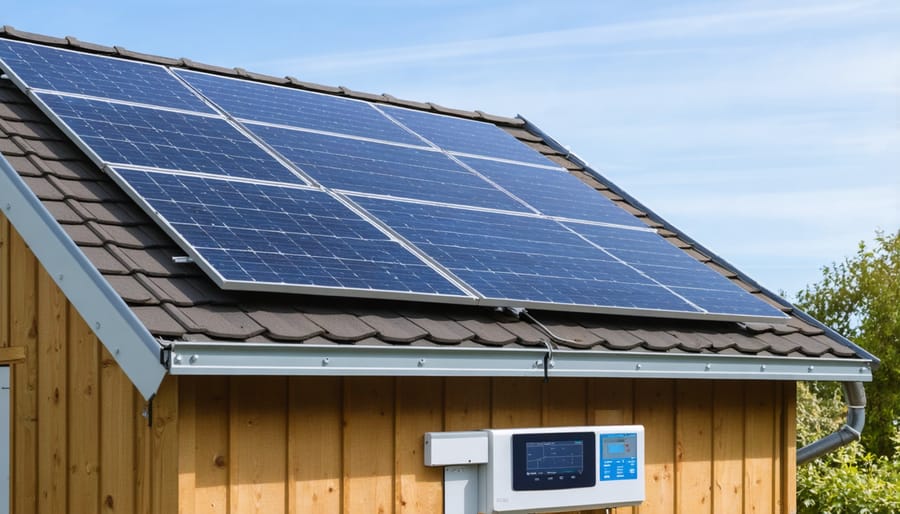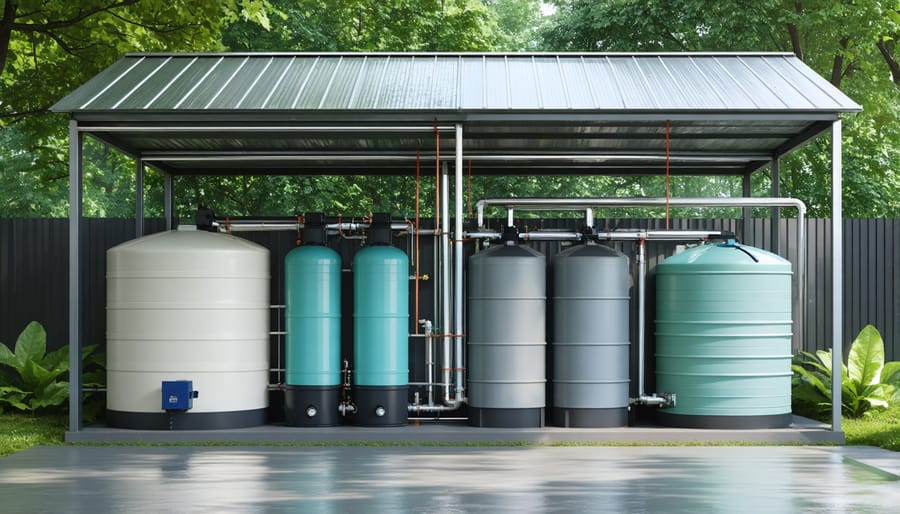Transform Your Lean-To Shed into an Eco-Friendly Storage Haven

Transform your unused space into a practical, cost-effective storage solution with a lean-to shed – the perfect addition that seamlessly attaches to an existing wall. These versatile structures blend naturally with your home’s architecture while creating valuable storage for tools, equipment, or eco-friendly storage solutions. By utilizing a single-slope roof design and sharing a wall with your home or garage, lean-to sheds minimize material costs and simplify construction while maximizing every square foot of available space. Whether you’re a DIY enthusiast or working with a contractor, these adaptable structures offer exceptional weather protection, require minimal maintenance, and can be customized to match your property’s aesthetic. The strategic placement against an existing structure not only saves space but also provides natural protection from the elements, making lean-to sheds an intelligent choice for homeowners seeking practical, sustainable storage options.
Sustainable Design Principles for Lean-To Sheds
Natural Lighting Solutions
Natural lighting can transform your lean-to shed into a bright, energy-efficient workspace while reducing your reliance on artificial lighting. Strategic placement of windows and skylights not only brightens your space but also helps regulate temperature throughout the year. When installing shed windows, consider positioning them on the east and south-facing walls to maximize sunlight exposure during peak hours.
Skylights are particularly effective in lean-to designs, as the sloped roof naturally accommodates their installation. Consider using double-glazed options to maintain temperature control while allowing ample natural light to flood your space. For optimal results, aim to have skylights cover about 10% of your floor area.
Position your workbench or storage shelves to take advantage of natural light zones, reducing the need for artificial lighting during daylight hours. Consider installing adjustable blinds or UV-protective films on your windows to control glare and heat during summer months while still maintaining visibility.
Remember to keep windows and skylights clean and well-maintained to maximize their light-transmitting efficiency. This simple maintenance routine ensures your natural lighting solution continues to work effectively year-round.

Eco-Friendly Material Selection
When building your lean-to shed, choosing eco-friendly materials not only helps the environment but can also result in a more durable and sustainable structure. Start with FSC-certified lumber, which ensures your wood comes from responsibly managed forests. Cedar and cypress are excellent natural choices, offering inherent resistance to decay and insects without requiring chemical treatments.
Consider recycled metal roofing panels, which are both sustainable and long-lasting. These panels often come with warranties of 30 years or more and can be recycled again at the end of their life cycle. For the siding, look into composite materials made from recycled wood fibers and plastic, offering the appearance of natural wood without the maintenance requirements.
For the foundation, explore permeable options like recycled concrete aggregate or reclaimed brick. These materials allow water to filter through naturally while providing a stable base for your shed. When it comes to insulation, opt for materials like recycled denim or sheep’s wool, which offer excellent thermal properties without harmful chemicals.
Don’t overlook salvaged materials – many homeowners have found success incorporating reclaimed doors, windows, and hardware into their lean-to designs. Local architectural salvage yards often offer unique pieces that add character while reducing environmental impact.
For finishes, choose low-VOC or natural paints and sealants to protect your shed while maintaining good air quality. Consider installing a green roof with sedums or other low-maintenance plants, which not only looks attractive but also provides additional insulation and helps manage rainwater runoff.
Remember, sustainable materials often cost more initially but tend to last longer and require less maintenance over time, making them a smart investment for both your property and the planet.
Energy-Efficient Features
Solar Integration Options
A lean-to shed’s sloped roof provides an ideal surface for solar panel installation, making it easier than ever to power your storage space sustainably. Most lean-to designs can support 2-4 standard solar panels, which is typically enough to power basic lighting, small tools, or device charging stations.
Before installing solar panels, ensure your shed roof faces south or southwest for optimal sun exposure. The typical 15-20 degree slope of a lean-to roof naturally provides the perfect angle for solar collection in most regions. For areas with less direct sunlight, consider installing adjustable mounting brackets to maximize energy capture.
Start small with a basic solar kit that includes a single panel, charge controller, and battery. This setup usually costs between $300-$500 and can power LED lights and small devices. As your needs grow, you can easily expand the system by adding more panels and storage capacity.
Don’t forget to incorporate proper ventilation in your design, as solar equipment generates heat. Installing a small solar-powered vent fan can help regulate temperature while using the energy you’re collecting. Consider running conduit during initial construction to make future solar integration easier and cleaner-looking.
For those seeking a simpler solution, portable solar generators or solar-powered lighting systems offer plug-and-play alternatives that don’t require permanent installation while still providing sustainable power for basic needs.

Insulation and Ventilation
Proper insulation and ventilation are crucial elements in creating a comfortable and functional lean-to shed that maintains its condition year-round. By implementing smart ventilation solutions, you can regulate temperature and humidity naturally, protecting both your stored items and the structure itself.
Start with the roof by installing reflective insulation material, which helps deflect summer heat while retaining warmth during colder months. Weather stripping around doors and windows prevents unwanted drafts and moisture infiltration. For wall insulation, consider using eco-friendly materials like recycled denim or sheep’s wool, which provide excellent thermal properties while being sustainable choices.
Natural airflow is essential for preventing moisture buildup and maintaining a healthy environment inside your lean-to shed. Install adjustable vents near the roof peak and along the base of the walls to create effective cross-ventilation. These vents can be opened during warmer months and partially closed during winter, allowing you to control airflow based on seasonal needs.
For enhanced temperature control, consider adding a solar-powered ventilation fan or a passive ventilation system using wind turbines. These options work without electricity and can significantly improve air circulation. During summer, you might also want to install shade cloth or climbing plants along the exposed wall to provide natural cooling.
Remember to leave a small gap between stored items and walls to promote air circulation and prevent condensation. This simple step, combined with proper insulation and ventilation, will help maintain an ideal environment for your stored belongings while extending the life of your lean-to shed.
Water Conservation Features
Rainwater Harvesting Systems
A rainwater harvesting system is an excellent addition to your lean-to shed, making it both eco-friendly and practical. The sloped roof design naturally lends itself to efficient water collection, requiring minimal modifications to get started. Begin by installing quality gutters along the lower edge of your shed’s roof, ensuring they’re properly angled for optimal water flow.
Connect your gutters to downspouts that lead to storage containers or rain barrels. Position these containers on a sturdy, level surface, preferably elevated on concrete blocks to enable gravity-fed distribution. A first-flush diverter is essential to filter out initial roof runoff, which often contains debris and contaminants.
For larger storage capacity, consider linking multiple rain barrels in series or investing in a larger cistern. Add mesh screens at collection points to keep out leaves and debris, and install overflow pipes to manage excess water during heavy rainfall. The stored water is perfect for garden irrigation, tool cleaning, or other outdoor tasks.
Safety tip: Always cover storage containers to prevent mosquito breeding and ensure child safety. Install secure lids that can be easily removed for maintenance but remain firmly in place during use. Consider adding a simple filtration system if you plan to use the water for more sensitive applications like greenhouse irrigation.
Remember to regularly clean your gutters and check all connections to maintain system efficiency. With proper maintenance, your rainwater harvesting system can significantly reduce your water bills while supporting sustainable gardening practices.

Greywater Integration
Integrating a greywater system into your lean-to shed design can significantly reduce water consumption while keeping your garden thriving. By collecting and filtering water from your home’s sinks, showers, or washing machine, you can create a sustainable irrigation solution for your garden beds adjacent to the shed.
Consider installing a simple gravity-fed system where greywater flows through PVC pipes from your home to a collection tank near your shed. The tank can be discreetly positioned behind or beside the structure, feeding into a drip irrigation system for nearby plants. Install a basic filter to remove soap residues and debris, ensuring safe water delivery to your garden.
For optimal results, use biodegradable soaps and cleaning products in your home, as these are gentler on plants. Position your shed’s gutters to direct rainwater into the same system, maximizing water collection. During installation, ensure proper slope in the piping (about 2%) to prevent water from standing and creating unwanted odors.
Remember to check local regulations regarding greywater systems before installation, as requirements vary by region.
Maintenance and Longevity
Eco-Friendly Cleaning Solutions
Maintaining your lean-to shed doesn’t require harsh chemicals that can harm the environment. By adopting sustainable maintenance practices, you can keep your shed clean and well-preserved while protecting the planet.
Create an all-purpose cleaner by mixing equal parts white vinegar and water in a spray bottle. This solution effectively removes dirt, mildew, and light stains from both interior and exterior surfaces. For tougher grime, add a tablespoon of baking soda to create a gentle scrubbing paste.
Natural oils like linseed or tung oil work wonderfully for protecting wooden elements of your shed. These plant-based alternatives to chemical sealants not only preserve the wood but also enhance its natural beauty. Apply them annually to maintain protection against moisture and weather damage.
For pest control, consider planting lavender, mint, or citronella around your shed’s perimeter. These natural deterrents keep unwanted visitors away while adding beauty to your garden. Inside, cedar blocks or dried herbs can help protect stored items from moths and other insects.
To remove musty odors, place bowls of coffee grounds or activated charcoal in corners. These natural deodorizers absorb unwanted smells without introducing artificial fragrances. Regular ventilation through windows or vents also helps maintain fresh air circulation, preventing moisture buildup and mold growth.
Regular Sustainability Checks
Regular maintenance checks are essential to ensure your lean-to shed remains environmentally friendly and efficient throughout its lifetime. Start by inspecting your green roof or solar panels quarterly, removing any debris and checking for optimal functionality. If you’ve installed rainwater collection systems, clean the gutters and filters monthly to prevent blockages and maintain water quality.
Examine your sustainable materials every six months for signs of wear or damage. Natural wood elements should be checked for rot or pest infestation, while recycled materials should be inspected for structural integrity. Pay special attention to weatherstripping and insulation to maintain energy efficiency, especially during seasonal changes.
Monitor your ventilation systems regularly to ensure proper air circulation and prevent moisture buildup. This includes checking vents, gaps, and any mechanical ventilation you’ve installed. For sheds with living walls or vertical gardens, establish a monthly care routine that includes pruning, fertilizing with organic materials, and checking irrigation systems.
Keep a maintenance log to track inspections and repairs, which helps identify patterns and potential issues before they become problems. Consider scheduling major sustainability checks during spring and fall when weather conditions are mild. This approach not only extends the life of your eco-friendly features but also maximizes their environmental benefits while potentially reducing long-term maintenance costs.
Remember to update and upgrade your sustainable systems as new, more efficient technologies become available, ensuring your lean-to shed remains as environmentally friendly as possible.
Converting your lean-to shed into a sustainable structure offers numerous long-term benefits that extend far beyond simple storage solutions. By implementing eco-friendly features, you’re not only creating a more efficient space but also contributing to environmental conservation while potentially reducing your maintenance costs over time. The integration of sustainable materials, proper insulation, and renewable energy solutions transforms a basic storage area into an environmentally responsible addition to your property.
The beauty of sustainable lean-to shed conversion lies in its versatility and adaptability. Whether you’ve incorporated solar panels for lighting, installed a rainwater harvesting system, or used recycled materials in your construction, each sustainable element adds value to your property while minimizing its environmental impact. These improvements often translate into tangible benefits, such as lower energy costs and reduced water consumption.
Moreover, a sustainable lean-to shed serves as an excellent example of how traditional storage solutions can be reimagined for modern environmental challenges. The durability of eco-friendly materials ensures your shed will stand the test of time, while features like green roofs and natural lighting create a more pleasant and functional space. By choosing sustainable options, you’re investing in a structure that not only meets your storage needs but also aligns with responsible environmental stewardship.
Remember that every sustainable feature you incorporate, no matter how small, contributes to a larger positive impact on the environment while enhancing the functionality and value of your storage space.

